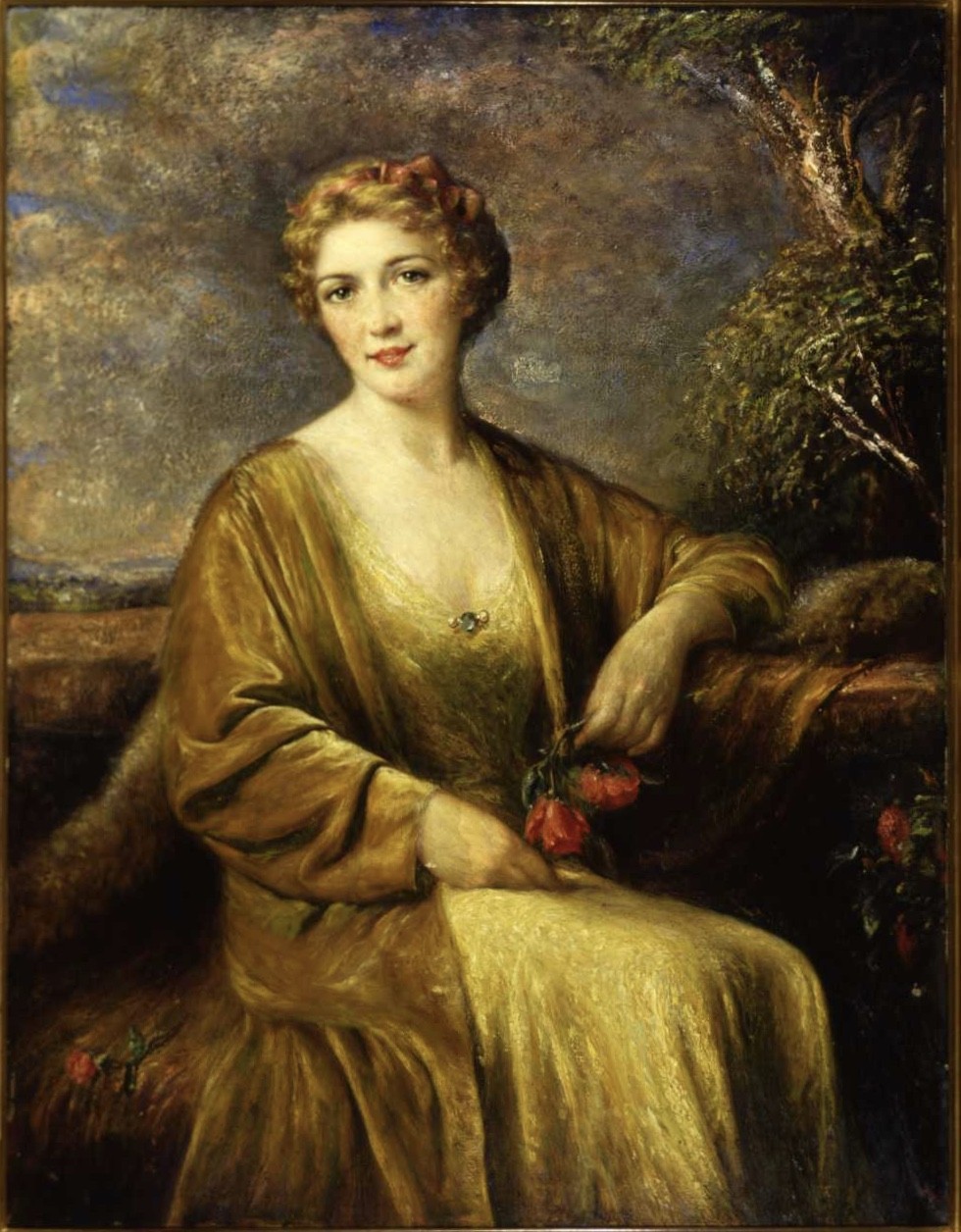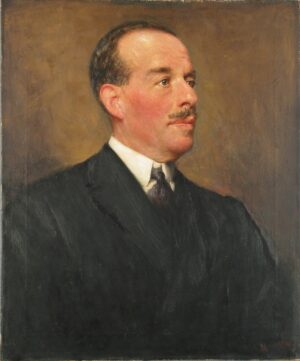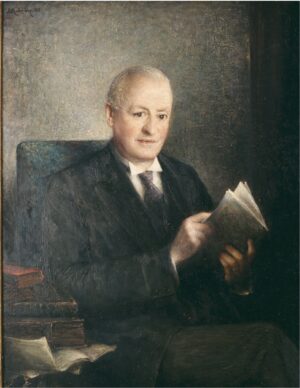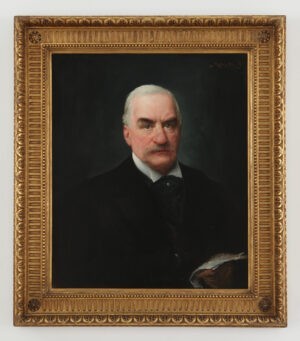Mrs. Wells, born Helen Mary Yost in c.1900, was the second wife of a film actor in Los Angeles called Norman Kerry (born Norman Hussey Kaiser), whom she married in New York on 2 November 1932, divorced on 17 September 1934, remarried about a year later, and then divorced at the end of World War II. Her first husband, a Mr. Wells, was apparently a New York grain broker. Norman Kerry was born in Rochester, New York on June 16, 1894 and died in Los Angeles on January 12. 1956. He played villains in silent films, but made a successful transition to sound films, retiring in 1941. In 1931 he made three films: Bachelor Apartment; Air-Eagles; and Ex-Frame.
Norman Kerry was an actor friend of Douglas Fairbanks (whom the artist saw often according to entries in his diaries 1931-1933), and Tom Geraghty: ‘Norman Kerry was the goat for more than one of their tricks. He was an actor friend whose addiction to the bottle was well known. He also kept pigeons, though at this late date there is no explanation for the unusual combination of tastes. Norman was amazed one morning on awakening with a hang-over to see his feathered pets flying about the yard with orange, red and purple wings. That was a bit of metamorphosis that had kept Doug and Tom busy for three hours earlier that morning.’ Ralph Hancock & Letitia Fairbanks, Douglas Fairbanks: The Fourth Musketeer, (London, Peter Davis, 1953), p. 141. This event took place in 1918 or 1919.
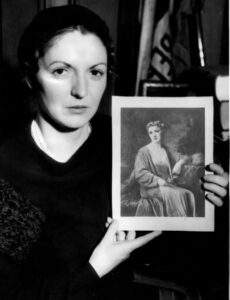
A press photograph from the time of the court case showing the now Mrs Norman Kerry holding a photograph of her portrait (Editor’s Collection)
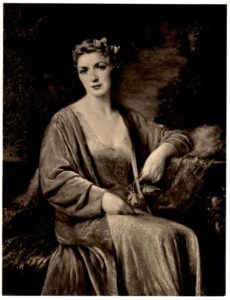
Mrs Wells’ portrait as originally conceived by Muller-Ury.
Mrs Wells commissioned Muller-Ury to paint her portrait for $4000.00 on the recommendation of a Mrs. Julia Rodenzo, an antique dealer in Los Angeles. But having completed the picture Mrs. Wells refused to accept the work – or pay the artist – because she claimed it was a poor likeness.
The artist tried to extract payment for nearly three years. In his diary for 2 February 1932, he says his lawyer, ‘McCarthy tells me that Mrs. Wells was called by Mr. Wells at Minneapolis and that he wants to pay the debts — this would be welcome.’ He then records on 6 March, ‘I feel that Mrs. Wells wants to go to Europe and so maybe she tries not to pay for the portrait, but McCarthy my lawyer knows her now and may be acting on this.’ But still no payment was received and in 1933 he decided to take the now Mrs. Norman Kerry to court in Los Angeles in a civil action. In his diary for Tuesday, 10 January 1933 he had written, ‘I hear from my lawyer that Mrs. Wells, now Mrs. Kerry, 212 South Ekamoni, Beverley Hills, wants some changes to the portrait and then she would like to pay – I do not believe but I hope.’ But Mrs Kerry seems to have been trying further delaying tactics, probably to postpone the legal case, but on 25 March, he reports that he had heard from his lawyer, Neil McCarthy, that the case “contra quella bugiarda ed infingarda di donna Mrs Wells di Minneapolis” would be heard on Monday, 10 April 1933.
On Friday, 7 April he writes in his diary, “I see Mme. Rodenzo and I am surprised to know that very few women in the world are honest. She tells me that that Mrs. Enstrom [? name unclear] woman that brought Mrs Wells to my studio would like to know if by winning the case I will pay her commission otherwise she would commit perjury to help Mrs. Wells and get money from her – It seems almost impossible!” The following Tuesday, 11 April, he writes, “I am very disconcerted to have to be called before the court in Los Angeles to defend myself against the vile action of Mrs Wells – now Mrs Norman Kerry – of not wanting to pay for the ideal portrait done of her.” The next day he wrote in his diary, “I went to the court for the case and never saw such idiots in action and in speaking than in this court with witnesses one more ignorant than the other. My lawyer Neil McCarthy who is also my friend does what is possible, but in such inartistic places and with such people what can you expect? I just hope I can vindicate the situation a little.”
In court Mrs. Rodenzo testified that Muller-Ury’s price for a two-thirds portrait was usually $6000.00, but that when Mr. Kerry told her his wife could not afford to pay more than $4000.00 she induced Muller-Ury to agree ‘because Mrs. Kerry is so beautiful’ (She may actually have meant Mr Wells.) Muller-Ury had even agreed to be paid in installments. In court Mrs. Kerry pointed out what she considered the defects of the work, and concluded that it did not look like her at all. The Chicago Tribune stated that Mrs Kerry ‘…told the court the painting added too many pounds to her figure.’ This does not sound as if it was the “ideal portrait” the artist claimed in his diary he had painted!
Judge Bush, however, ruled in the artist’s favour. The painting was auctioned by the Sheriff’s Office to help pay Muller-Ury, but there were only two bidders, the Curator of the Art Gallery at the University of Southern California who bid $100.00, and McCarthy bidding for the artist himself who bought it back for $150.00. Presumably Mrs. Kerry still had to pay the artist the remainder of the $4500 ?
The Chicago Tribune illustrated the portrait it its original frame (cost evidently $322). The largish frame in which Count Antoine Seilern’s portrait was returned to Switzerland in 1947 bears the words, ‘Mrs. Wells, Minneapolis’ in the artist’s handwriting, but this is not the original frame, which was certainly a Newcomb-Macklin type frame.
The artist, who kept the picture in his studio and exhibited it apparently twice in New York in 1937 and 1947, until it was eventually acquired by Jessica Dragonette, evidently altered the picture after he bought it back at the Sheriff’s Sale, and made it look even less like Mrs Wells Kerry.


